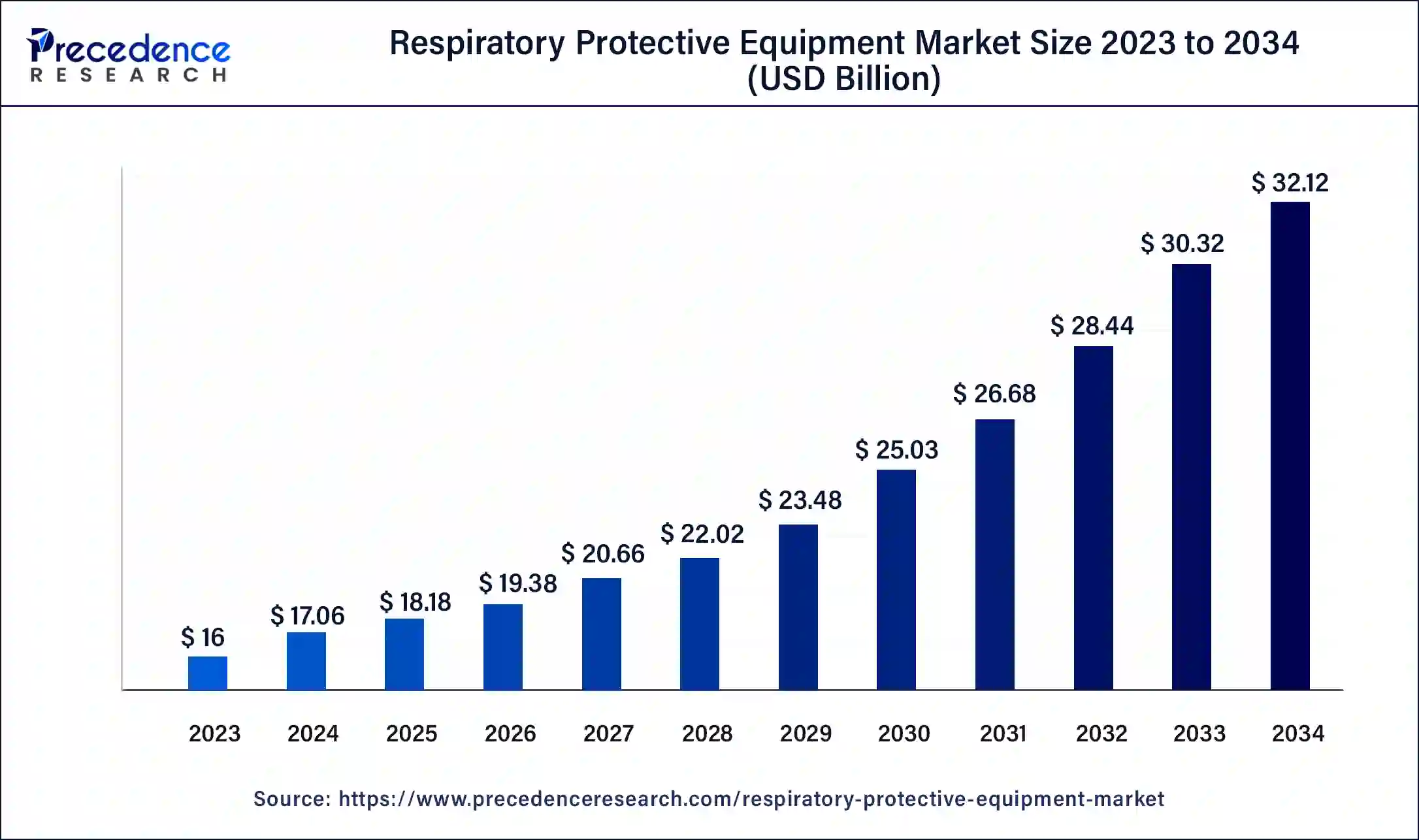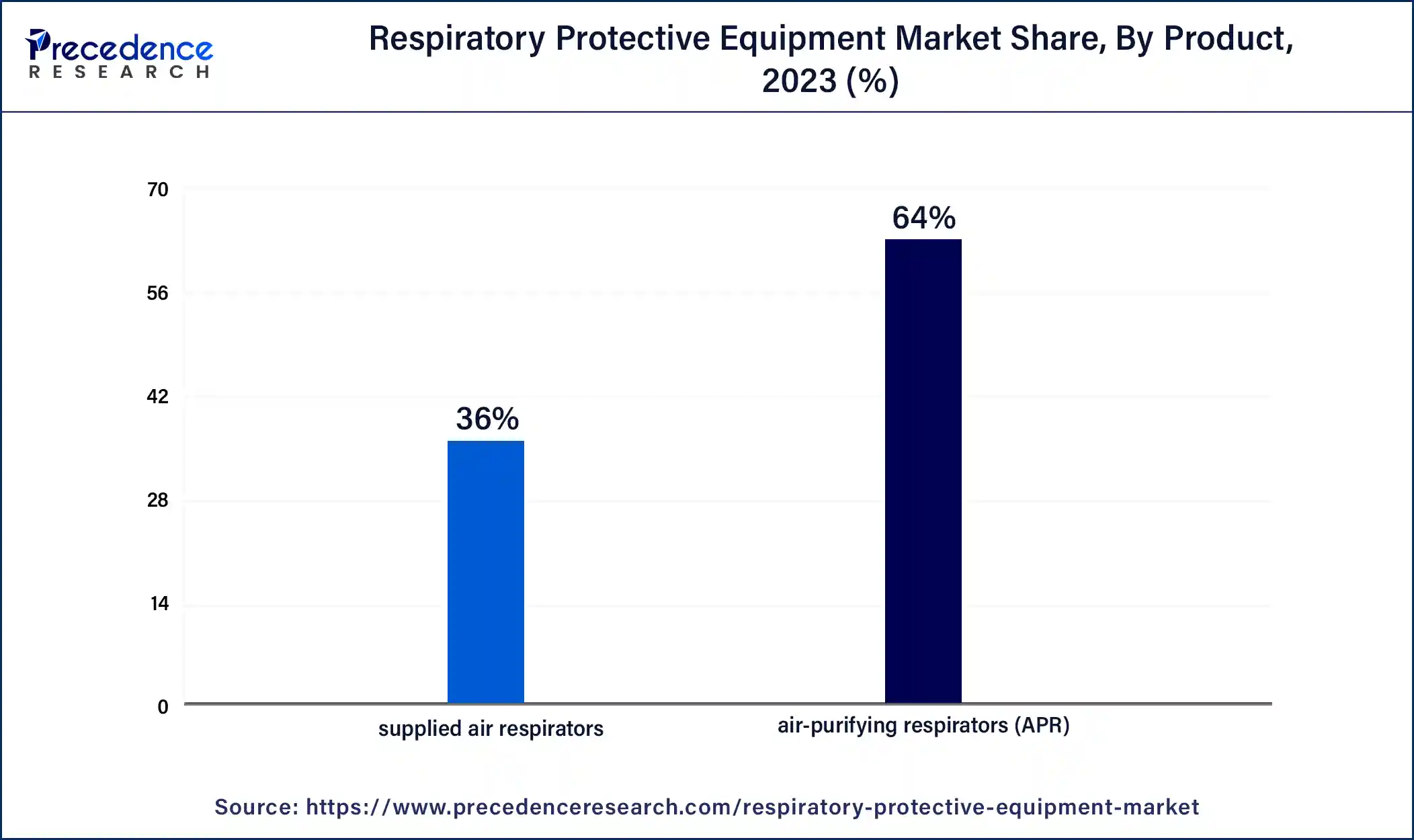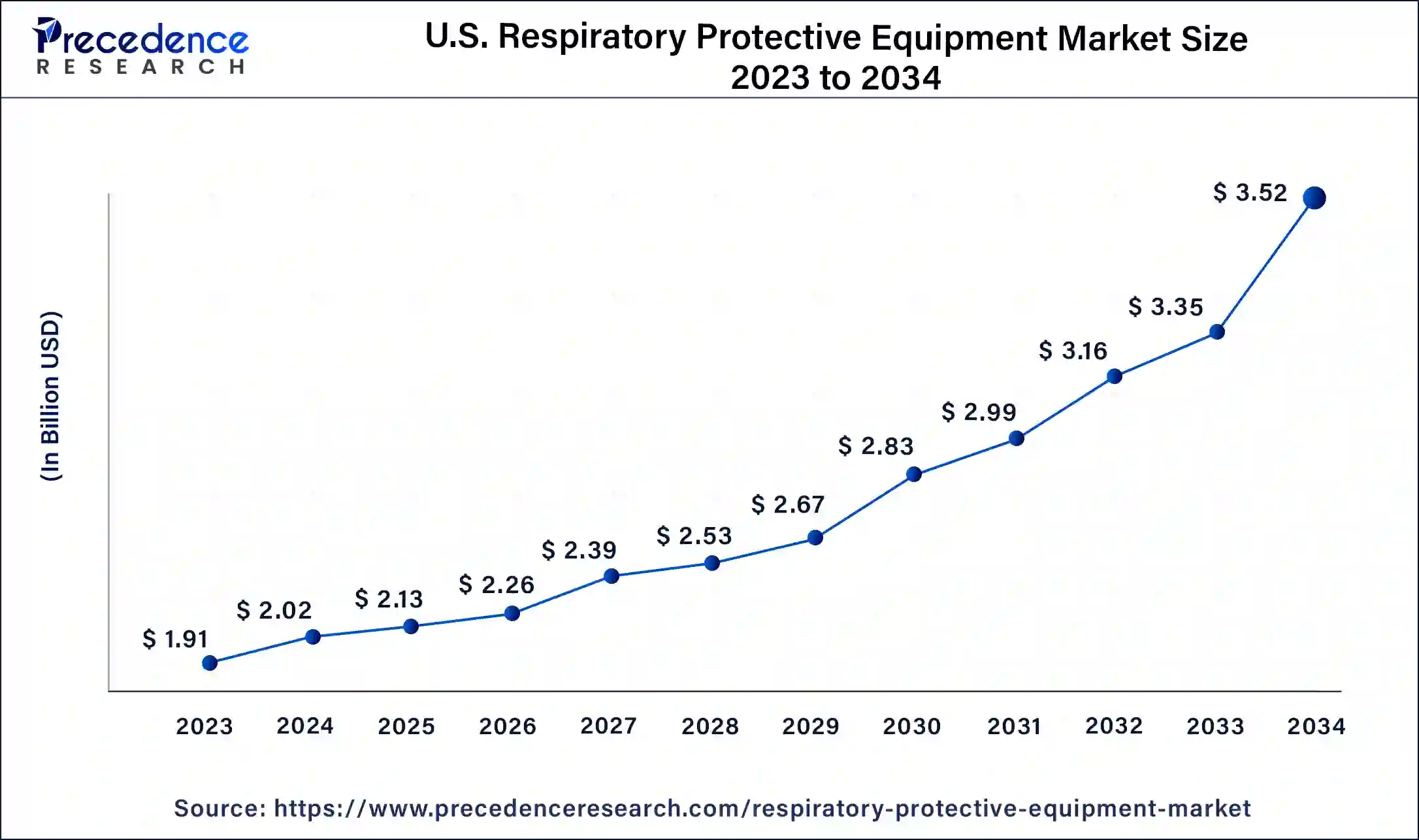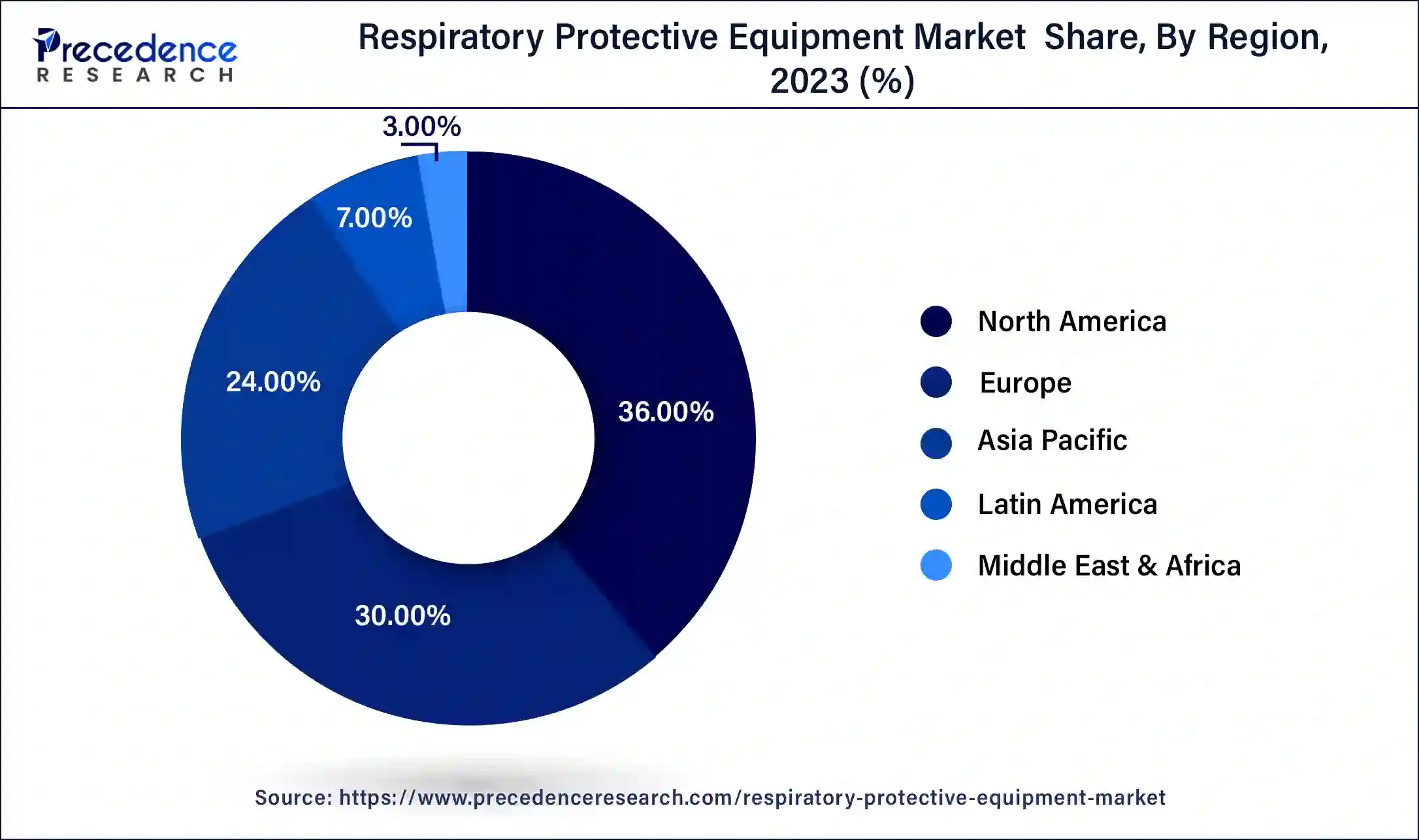What is Respiratory Protective Equipment Market Size?
The global respiratory protective equipment market size accounted for USD 18.18 billion in 2025, and is anticipated to hit around USD 19.38 billion by 2026, and is predicted to reach around USD 32.12 billion by 2034, growing at a CAGR of 6.53% from 2025 to 2034.

Market Highlights
- North America contributed more than 36% of revenue share in 2024.
- Asia-Pacific is estimated to expand the fastest CAGR between 2025 and 2034.
- By product, the air-purifying respirators (APR) segment has held the largest market share of 64% in 2024
- By product, the supplied air respirators (SARs) segment is anticipated to grow at a remarkable CAGR of 7.8% between 2025 and 2034.
- By end use, the healthcare segment generated over 25% of revenue share in 2024.
- By end use, the mining segment is expected to expand at the fastest CAGR over the projected period.
Respiratory Protective Equipment Market Overview: Understanding the Modern Innovations
Respiratory Protective Equipment (RPE) is a vital category of personal safety gear crafted to shield individuals from inhaling harmful substances in the air. It encompasses an array of devices and accessories that establish a barrier between the respiratory system and potential hazards like airborne particles, gases, vapors, and biological contaminants. Essentially, RPE serves to prevent the intake of pollutants that could pose risks to respiratory health.
RPE comes in diverse forms, from disposable masks to advanced respirators fitted with filters and purifying mechanisms. Widely used in sectors like healthcare, manufacturing, construction, and emergency response, these devices play a pivotal role in safeguarding workers exposed to airborne threats. Choosing the right type of RPE, ensuring proper fit, and adhering to correct usage procedures are critical elements to guarantee its efficacy in providing a dependable defense against respiratory risks. This commitment to occupational safety standards underscores the significant role RPE plays in preserving the well-being of individuals across various professional settings.
Respiratory Protective Equipment Market Growth Factors
- Increasing Awareness: Growing awareness regarding workplace safety and the importance of respiratory protection is driving the demand for Respiratory Protective Equipment (RPE).
- Stringent Regulations: Stringent occupational health and safety regulations worldwide are compelling employers to invest in high-quality RPE to ensure compliance and protect workers.
- Pandemic Preparedness: The COVID-19 pandemic has heightened the need for respiratory protection, influencing industries to prioritize RPE for employee well-being.
- Rising Industrialization: Ongoing industrialization in emerging economies is boosting the requirement for RPE across various sectors to mitigate occupational respiratory risks.
- Technological Advancements: Continuous advancements in RPE technologies, such as innovative filtration systems and smart respiratory devices, are attracting market growth.
- Increasing Healthcare Expenditure: Rising healthcare expenditure globally is contributing to the growth of the medical-grade respiratory protective equipment market.
- Expansion of End-use Industries: Growth in construction, manufacturing, and healthcare sectors is expanding the application areas for respiratory protection equipment.
- Heightened Environmental Concerns: Growing concerns about air quality and environmental pollution are driving demand for RPE in both industrial and non-industrial settings.
- Focus on Worker Well-being: Companies are increasingly recognizing the importance of prioritizing employee health, spurring the adoption of respiratory protection measures.
- Globalization of Trade: The globalization of trade is increasing the cross-border movement of goods and people, emphasizing the need for standardized respiratory protection.
- Research and Development Initiatives: Investments in research and development are leading to the creation of more efficient and comfortable respiratory protection solutions.
- Surge in Respiratory Ailments: The rise in respiratory illnesses is propelling the demand for respiratory protective equipment, especially in healthcare and pharmaceutical settings.
- Increasing Urbanization: Rapid urbanization is fueling construction activities, contributing to the demand for respiratory protection in the construction industry.
- Focus on Sustainable Practices: Growing emphasis on sustainability is encouraging the development of eco-friendly and reusable respiratory protective equipment.
- Changing Demographics: Shifting demographics, including an aging workforce, are influencing the need for specialized respiratory protection in various industries.
- Economic Growth: Positive economic growth is fostering increased investments in occupational safety measures, including respiratory protection.
- Global Health Crises Preparedness: Recent health crises have underscored the importance of being prepared, driving governments and industries to invest in respiratory protection.
- Increased Manufacturing Output: Growth in manufacturing output is boosting the adoption of respiratory protective equipment to ensure worker safety in industrial settings.
- E-commerce Boom: The surge in e-commerce activities is driving the demand for respiratory protection among warehouse and logistics personnel.
Major Key Trends in Respiratory Protective Equipment Market
- Incorporation of Smart Technologies: RPE increasingly integrates IoT and sensor technologies, allowing for real-time monitoring of air quality and filter performance, thereby improving user safety and equipment efficiency.
- Focus on Sustainability: Manufacturers are prioritizing eco-friendly materials and reusable designs in RPE, addressing environmental issues and minimizing waste linked to disposable protective gear.
- Enhancements in Comfort and Usability: Contemporary RPE designs emphasize user comfort through features like lightweight materials, adjustable straps, and ergonomic fits, promoting extended wear and greater compliance in various work environments.
Respiratory Protective Equipment Market Outlook: Towards the Smart Respirators
- Industry Growth Overview: Growing health risk awareness, rapid industrialization, stringent government safety regulations, and technological advancements are responsible for industry growth.
- Major Investors: Large diversified institutions, shareholders, and private equity firms are the major investors in the market.
- Startup Ecosystem: The development of smart user-centric and sustainable solutions is the focus of the startup ecosystems.
Market Scope
| Report Coverage | Details |
| Market Size in 2025 | USD 18.18 Billion |
| Market Size in 2026 | USD 19.38 Billion |
| Market Size by 2034 | USD 32.12 Billion |
| Growth Rate from 2025 to 2034 | CAGR of 6.53% |
| Largest Market | North America |
| Base Year | 2024 |
| Forecast Period | 2025 to 2034 |
| Segments Covered | Product, End-Use, and Region |
| Regions Covered | North America, Europe, Asia-Pacific, Latin America, and Middle East & Africa |
Market Dynamics
Drivers
Growing awareness and pandemic impact
Growing awareness and the impact of the COVID-19 pandemic have synergistically surged the market demand for respiratory protective equipment (RPE). As awareness regarding the importance of workplace safety and the potential respiratory hazards associated with various industries increases, both employers and employees recognize the need for robust protective measures. This heightened consciousness is driving a proactive approach towards respiratory health, resulting in a substantial uptick in the adoption of RPE across diverse sectors.
The COVID-19 pandemic has further accelerated the demand for respiratory protection, emphasizing the crucial role of RPE in curbing the transmission of respiratory diseases. Governments, businesses, and individuals globally are prioritizing respiratory safety measures, resulting in an increased demand for top-quality masks, respirators, and related protective equipment. The combined influence of heightened awareness and pandemic-related concerns is reshaping the landscape of the respiratory protective equipment market, positioning it as a pivotal element in modern workplace safety and public health strategies.
Restraint
Training requirements and limited user awareness
Training requirements and limited user awareness collectively act as significant restraints on the market demand for respiratory protective equipment (RPE). The necessity for comprehensive training programs to educate users on the proper selection, usage, and maintenance of RPE can impose a constraint on businesses, demanding additional resources and time commitments. Ensuring that users are adequately trained is crucial for the effective utilization of respiratory protection, but the associated costs and efforts can deter widespread adoption.
Limited user awareness compounds this challenge, as gaps in understanding regarding the importance of respiratory protection may lead to inconsistent or incorrect usage. Despite growing overall awareness, some users may still lack the knowledge needed to make informed decisions about the appropriate RPE for their specific environments. Overcoming these restraints requires targeted education campaigns and accessible training programs to enhance user awareness and ensure proper utilization of respiratory protective equipment in diverse industries.
Opportunity
E-commerce expansion and global health concerns
The expansion of e-commerce and heightened global health concerns are creating significant opportunities in the Respiratory Protective Equipment (RPE) market. The growing prevalence of online platforms allows manufacturers to leverage e-commerce channels for the convenient and efficient distribution of respiratory protection products. This expansion enhances accessibility, enabling a broader reach to consumers and facilitating streamlined supply chains.
Online platforms also offer a platform for educating users about the importance of respiratory protection, fostering awareness and promoting informed decision-making. Global health concerns, particularly in the wake of events like the COVID-19 pandemic, are driving increased demand for respiratory protective equipment.
The focus on pandemic preparedness, along with ongoing health crises, has elevated the importance of RPE across various sectors. Governments, businesses, and individuals worldwide are prioritizing respiratory safety, creating opportunities for manufacturers to meet the heightened demand for high-quality protective gear. This convergence of e-commerce expansion and global health concerns positions the RPE market at the forefront of ensuring widespread access to essential safety measures on a global scale.
Segment Insights
Product Insights
In 2024, the air-purifying respirators (APR) segment held the highest market share of 64% on the basis of the product. Air-purifying respirators (APR) belong to the category of respiratory protective equipment that works by cleansing the air before inhalation. These respirators employ filters to eliminate particles and harmful elements from the surrounding air, offering protection against gases and vapors. A notable trend in the APR segment involves the integration of advanced filtration technologies, like HEPA and carbon filters, to enhance their efficacy. Manufacturers are also emphasizing user comfort by incorporating ergonomic designs and user-friendly features, promoting better adherence to respiratory safety standards in various industries.

The supplied air respirators (SARs) segment is anticipated to witness the highest growth at a significant CAGR of 7.8% during the projected period. Supplied Air Respirators (SARs) are a critical segment in the Respiratory Protective Equipment (RPE) market, providing a continuous supply of clean air to the wearer through an external source. SARs eliminate the need for filters and rely on a remote air source, offering enhanced protection in environments with contaminants.
A notable trend in the SARs segment involves the integration of advanced technologies for improved comfort, communication features, and compatibility with other personal protective equipment, catering to the evolving needs of diverse industries such as healthcare, construction, and manufacturing.
End Use Insights
According to the end use, the healthcare segment held a 25% revenue share in 2024. The healthcare segment in the Respiratory Protective Equipment (RPE) market pertains to the use of respiratory protection in medical settings. With the ongoing emphasis on infection control, the healthcare sector is witnessing a surge in demand for high-performance RPE. Trends include the adoption of advanced respirators with enhanced filtration capabilities, increased use of powered air-purifying respirators (PAPRs), and the development of innovative, comfortable designs to ensure optimal respiratory protection for healthcare professionals in various medical environments.
The mining segment is anticipated to witness the highest growth over the projected period. The mining segment in the Respiratory Protective Equipment (RPE) market refers to the use of respiratory protection in mining operations to safeguard workers from inhaling harmful particles, dust, and gases.
In this sector, the demand for RPE is driven by the need to mitigate the risk of respiratory hazards prevalent in mining environments, including silica dust and various airborne contaminants. Current trends in the mining segment include the adoption of advanced respiratory technologies, increased focus on user comfort, and the development of robust, durable RPE to enhance worker safety in mining operations.
Regional Insights
U.S. Respiratory Protective Equipment Market Size and Growth 2025 To 2034
The U.S. respiratory protective equipment market size is valued at USD 2.13 billion in 2025 and is expected to be worth around USD 3.52 billion by 2034, growing at a CAGR of 6.61% from 2025 to 2034.

Robust Industries Fuels U.S.
The presence of robust industries in the U.S is increasing the demand for respiratory protective equipment. They are also being used in construction and mining operations. Additionally, the presence of stringent workplace safety standards is promoting the adoption of this equipment.
Stringent Regulations Drive North America
North America held the largest revenue share 36% in 2024. North America holds a major share in the respiratory protective equipment (RPE) market due to stringent occupational safety regulations, a robust industrial sector, and heightened awareness of workplace safety standards. The region's emphasis on health and safety compliance, coupled with the presence of key market players and a proactive approach to adopting advanced respiratory protection technologies, contributes to its dominant market share. Additionally, increasing concerns about respiratory health, especially in light of the COVID-19 pandemic, have further accelerated the demand for high-quality RPE in North America.
Robust Industrialization Boosts the Asia Pacific
Asia-Pacific is estimated to witness the highest growth. Asia-Pacific holds a significant share in the respiratory protective equipment (RPE) market due to several factors. The region's robust industrialization, particularly in manufacturing and construction, contributes to increased demand for RPE to ensure worker safety. Additionally, stringent regulatory frameworks emphasizing occupational health and safety standards drive market growth. The heightened awareness of respiratory risks, coupled with the region's response to global health concerns, further amplifies the adoption of RPE. The Asia-Pacific market continues to expand as businesses prioritize employee well-being, fostering the widespread use of respiratory protection across diverse industries.
Europe Driven by Strict Safety Regulations
Europe is observed to grow at a considerable growth rate in the upcoming ?period, propelled by stringent occupational safety regulations and a robust industrial sector. Nations such as Germany, France, and the UK prioritize workplace health, which has resulted in widespread usage of RPE in industries like manufacturing, construction, and healthcare. The region's commitment to sustainable and high-quality protective gear has led to a growing demand for innovative RPE solutions. Furthermore, initiatives focused on promoting workplace safety and health awareness are contributing to the consistent expansion of the RPE market throughout Europe.
The Advanced Manufacturing Industry Propels Germany
Germany is a key player in the European RPE market, marked by its advanced manufacturing industry and strict safety regulations. The nation's focus on worker protection has resulted in extensive use of RPE across various sectors. Innovations such as smart respirators and eco-friendly materials are rising in popularity, consistent with Germany's dedication to technological progress and environmental stewardship. The integration of digital technologies in RPE further enhances safety and compliance in the workplace
Largest Manufacturing Hub Transforms China
Due to the presence of the largest manufacturing hub in China, the development of respiratory protective equipment is increasing. The expanding industrial sectors and government regulations are increasing their demand, where the industries are developing affordable solutions.
Expanding Industrial Activities Enhance South America
South America is expected to grow in the respiratory protective equipment market during the forecast period, due to expanding industrial activities. Therefore, to establish safety measures, the demand for respiratory protective equipment across various sectors is increasing. The growing infectious diseases are also increasing their use in hospitals and clinics. These advancements are promoting the market growth.
Growing Mining Operations Facilitate Brazil
The growth in the mining operations is increasing their utilization, where the growing diseases are also increasing their demand in the healthcare sector. The growing environmental awareness and safety concerns are also contributing to their increasing adoption rates.
Value Chain Analysis
- Feedstock Procurement: Feedstock procurement of respiratory protective equipment involves sourcing polypropylene and aluminum or steel.
Key players: Honeywell International Inc., 3M, Kimberly-Clark Corporation. - Quality Testing and Certification: The quality testing and certification of the respiratory protective equipment includes performance and fit tests.
Key players: 3M, Kimberly-Clark Corporation, Alpha Pro Tech. - Regulatory Compliance and Safety Monitoring: The safety, performance, and adverse events of the respiratory protective equipment are evaluated in their regulatory compliance and safety monitoring.
Key players: Honeywell International Inc., 3M, Kimberly-Clark Corporation.
Respiratory Protective Equipment Market Giants: Key Players' Offering
- 3M: The company provides 3M 6000/7500 series, 3M Aura series, 3M Versaflo, and 3M Scott.
- MSA Safety Inc.: The company provides the MSA G1 and Advantage series.
- Honeywell International Inc.: Honeywell North, Honeywell One-fit, Scott safety, etc, are provided by the company.
- Kimberly-Clark Corporation: The company provides a wide range of disposable respirators, masks, and protective clothing.
- Dragerwerk AG & Co. KGaA: Drager X-plore is provided by the company.
Recent Developments
- In March 2023, 3M declared an increase in its N95 respirator production capacity to address the persistent demand in both healthcare and industrial sectors. This initiative aims to bolster supply chain resilience and guarantee the availability of essential protective equipment.
- In January 2024, Honeywell unveiled a new series of reusable half-mask respirators that feature enhanced comfort and adjustable fittings, targeting the construction and manufacturing sectors. The design emphasizes durability and user comfort for prolonged usage.
- In July 2023, Drägerwerk AG & Co. KGaA launched a cutting-edge powered air-purifying respirator (PAPR) designed for hazardous industrial settings. The new system boasts improved battery life and filtration efficiency, catering to the requirements of workers in demanding conditions.
- In June 2022, Avon Protection Plc, formerly recognized as Avon Rubber Plc, revealed a new line of EXOSKINTM CBRN gloves and boots designed to serve as respiratory protective equipment for military personnel.
- 3M, in May 2022, declared its intentions to expand its operations in Valley, Nebraska, with a focus on increasing the production of hearing and respiratory protection products.
- Bullard, in August 2021, introduced the SALUS-HC, an air purifying respiratory protective equipment aimed at ensuring the safety of workers in public and healthcare settings.
- In January 2021, MSA Safety Inc. completed the acquisition of Bristol Uniforms, a UK-based company, with the aim of offering firefighters reliable and innovative respiratory protective equipment.
Segments Covered in the Report
By Product
- Air Purifying Respirators (APR)
- Supplied Air Respirators
By End-Use
- Oil & Gas
- Fire services
- Petrochemical/chemical
- Industrial
- Pharmaceuticals
- Construction
- Healthcare
- Mining
- Others
By Region
- North America
- Europe
- Asia-Pacific
- Latin America
- Middle East and Africa
For inquiries regarding discounts, bulk purchases, or customization requests, please contact us at sales@precedenceresearch.com
Frequently Asked Questions
Ask For Sample
No cookie-cutter, only authentic analysis – take the 1st step to become a Precedence Research client




 sales@precedenceresearch.com
sales@precedenceresearch.com
 +1 804-441-9344
+1 804-441-9344